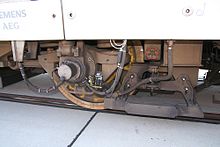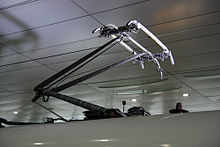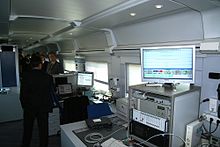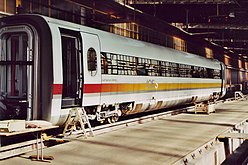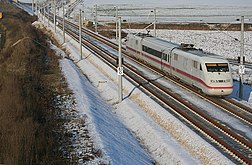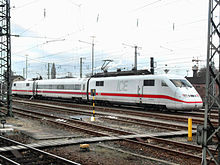ICE S.
| 410.1 | |
|---|---|
|
The ICE S in September 2007 on the SFS Ingolstadt – Nuremberg during a test run
|
|
| Number: | 1 |
| Gauge : | 1435 mm ( standard gauge ) |
| Length: | 120.32 m (three intermediate cars), power cars : each 20,560 mm |
| Height: | 3820 mm (powered end car), 3856 mm (intermediate car) |
| Width: | 3070 mm (power car), 3020 mm (intermediate car) |
| Empty mass: | 79 t ( powered end cars) , 55/57/55 t (intermediate car) |
| Top speed: | 393 km / h, regular measurement runs: 330 km / h (theoretical: |
| Continuous output : | 9,600 kW (only power cars) , 13,600 kW (with powered intermediate car) |
| Power system : | 15 kV 16.7 Hz |
| Power transmission: | Pantograph |
| Number of traction motors: | 4 per power car |
The ICE S ("S" for high-speed travel or high-speed travel , since around 2006 also ICE R , "R" for reference vehicle ) is a test train from Deutsche Bahn . It belongs to the 410.1 series (from ICE 2 ) and is the successor to the InterCityExperimental (ICE V). The highest speed that the ICE S ever reached was 393 km / h on the high-speed route Hanover – Berlin between Oebisfelde and Berlin . The theoretical maximum speed of the vehicle is 440 km / h.
configuration
today
The now 76 meters long and 211 tons of heavy train consists of a flask equipped with instruments measuring carriage and two modified ICE-2- power heads ( 410101-0 and 410102-8 ). These were equipped with a modified gear ratio. The maximum speed in normal operation is 280 km / h, in test operation (theoretically) around 400 km / h. The maximum traction power is 9,600 kW .
The 810 101-6 has been the only intermediate car in the train set since mid-2006 , formerly one of the three intermediate cars of the original ICE S ( 410 201-8 with bogies of the ICE 3). This mainly contains measuring devices and facilities. The train belonging to DB Systemtechnik was stationed in Minden / Westphalia until February 7, 2006 , and has been in Munich since then . Before that, a converted first-class car ( 801 422-7 ) from a regular ICE 1 train was used for a long time , but it was needed as part of the ICE 1 redesign program.
The measurement and test train has numerous modifications compared to the regular ICE trains . Due to the short length of the train, both pantographs must not be lifted, as the rear pantograph would not have secure contact with the overhead line that is vibrating . Therefore, a high-voltage line running on the roof connects the two power cars. The intermediate cars are equipped with bogies of the ICE 3 , the front bogie of one of the power cars with a modified measuring bogie, which is also used to measure the route. Strain gauges connected to Wheatstone's full bridges record the forces occurring in the track area and transmit the data from 96 measuring channels via fiber optics from the power car to the intermediate car, in which a measuring computer processes and records the values. A program from DB Systemtechnik is to reduce the fleet of measuring trains from 20 to 10 vehicles by 2010 . This is why the ICE S 2008 is being given additional measuring equipment so that it can carry out even more measurements at the same time.
In addition to numerous sensors, cameras and two spotlights each are installed on the roof to monitor the two pantographs and the overhead line. It is also possible to raise the bracket directly under the overhead contact line for aerodynamic measurements without current . The speedometer sheet in the driver's cab runs in steps of 50 up to 450 km / h.
Previous configuration
Originally, the ICE S was used to test components for the ICE 3, for example the eddy current brake , a multi-system pantograph, an air conditioning system with air as the refrigerant and, in particular, the distributed drive. The train was constructed in five parts: a powered intermediate car 1 , a non-powered intermediate car ( measuring car 1 ) and another powered intermediate car ( intermediate car 2 ) were positioned between the two power cars .
The train was formed from two power cars and three intermediate cars:
- Power end 410 101-0
- powered middle car 410 201-8 ("middle car 1"). This car was equipped as a "VIP car" for accompanying guests with 41 1st class seats, a bar and two toilets.
- non-driven measuring carriage 410 801-5. This car contained most of the measurement technology as well as PC workstations and a compartment for meetings.
- powered intermediate car 410 202-6 ("Mittelwagen 2"). This car contained a separate measuring compartment as well as temporary workplaces and also served as a warehouse.
- Power end 410 102-8
The power cars are owned by Deutsche Bahn, the three original intermediate cars are owned by Siemens and Adtranz (now Bombardier ).
All axles on the two driven intermediate cars were equipped with traction motors, whereby two different drive concepts were tested. The axle-mounted drive with curved tooth coupling tried and tested on intermediate car 1 was the preferred variant for the ICE 3, which, however, had not yet been tested in Europe. A conventional, fully sprung, hollow shaft drive was therefore tested in intermediate car 2 .
The measuring car, which was manufactured in the underfloor area similar to the ICE 3, accommodated the essential parts of the AC system for the drive ( main transformer , main switch, earthing switch and isolating switch). In addition, the car had its own pantograph (15 kV). The pulse inverters in both intermediate cars were fed via a four-quadrant controller and a DC voltage intermediate circuit (2,800 V), which in turn each supplied four asynchronous traction motors with an output of 500 kW each. The three alternating current pantographs were connected to one another via a high-voltage line. In order to accommodate the drive under the originally non-powered car, the floor in the area of the bogies was raised by a few centimeters.
In this configuration it had a maximum drive power of 13,600 kW. The basic electrical structure corresponded to that of an ICE 3 quarter train with four cars, combined into three cars. In addition to the pantographs on the two powered end cars, intermediate car 2 had a 25 kV pantograph (for the French and Belgian networks) and a 1.5 / 3 kV pantograph (direct current, for the Netherlands and Belgium). These two current collectors were only used for aerodynamic and contact measurements and were not electrically connected.
In this configuration, the train's braking systems were designed for braking on slopes of up to 330 km / h. In addition to generator and disc brakes (two to three brake discs per shaft), as they were already used in the previous ICE series, the measuring vehicle was equipped with a linear eddy current brake, as was also intended for the ICE 3. For this purpose, both running bogies of the measuring car were equipped with two brake magnets each, which were lowered down to 5 mm on the upper edge of the rail when braking. The eddy current brake was supplied with power via the converter on intermediate car 1. In addition to testing the functionality of the new brake system on the train, the effects on the safety technology and the dynamic behavior of the brake were also examined.
For the first time in the rail sector, air conditioning systems were used in the ICE S (in the middle car 1 and measuring car) that used air as the process gas. The other innovations incorporated into the ICE 3 series trains also include a control system based on the Train Communication Network . With the ICE S, measuring wheelsets with real-time evaluation of data were also used for the first time in Europe.
In 1997, the ICE S was initially only traveling at speeds of over 300 km / h in exceptional cases. The speeds of around 360 km / h required for approval for 330 km / h could only be achieved with the completion of the high-speed line from Hanover to Berlin.
When the ICE 3 went into operation, the two powered intermediate cars were parked in the summer of 1999 after two years of use. In 2007, an 8 m long element of an outer wall was installed from one of the decommissioned cars in an ICE-2 car, the outer shell of which had been damaged by frost damage.
The 410 202-6 car was used in test operations from 1997 to 1999 and then parked on the grounds of the Minden Research and Technology Center. It was offered for sale in March 2017 for 10,000 euros.
Special configurations
The ICE S drove several times for various test and acceptance drives in an extended configuration. For this purpose, several intermediate cars from regular ICE 1 or ICE 2 vehicles were temporarily used in the ICE S. Also prototype wagons of newly developed trains, which often came from Siemens AG, were / will be included in the ICE S for testing.
- In January 2006, the ICE S drove with 7 intermediate cars to inspect the Nuremberg – Ingolstadt – Munich high-speed line .
- In April 2006 the ICE S drove with one of its intermediate cars and an additional 6 ICE-1 intermediate cars for the acceptance of the high-speed route Cologne – Aachen .
- In July 2011, the ICE S drove with one of its intermediate cars and an additional 6 ICE-1 intermediate cars for the acceptance of the high-speed route Augsburg-Munich .
- In August 2012, the ICE S undertook test drives on the Vienna-St. Pölten . This was also done in a 1 + 6 configuration.
- In April 2015, the ICE S made acceptance runs on the Erfurt-Halle / Leipzig high-speed line . In addition to the two main cars, five ICE 1 intermediate cars were added.
- Two months later, in June 2015, another (different) ICE-S configuration consisting of two main cars and five ICE-1 intermediate cars was tested in Minden.
- In November 2015, the ICE S drove through the Gotthard Base Tunnel with 3 additional ICE 1 intermediate cars as part of several measurement runs.
- Since April 2018, a prototype car of the " Velaro Novo ", a new high-speed train, has been tested with the ICE S. Various components are tested and measurements are made in the near-series car body.
tasks
The train is used for acceptance and (two to three times a year) inspection runs on high-speed lines. In addition to the track position and the wheel-rail forces that occur , pantographs and the position of the catenary are also checked (for example as part of the F6 catenary function test on all routes with a maximum speed of more than 160 km / h). For this purpose, workstations for a measuring or test manager and his employees, for checking the route and for the interaction of overhead line and pantograph are set up in the intermediate car. It is planned that he should also check the radio quality of the GSM-R network.
A key task of the train continues to be the testing and approval of new technologies for high-speed traffic.
history
The ICE S developed by the ICE 2 consortium ( Siemens / Adtranz ) was included in the inventory from June 6, 1997. Testing of the ICE S began in the summer of 1997 in the Wegberg-Wildenrath test center , where the train was officially presented to the public in November of the same year. The first test drives were carried out on the new sections Hanover – Göttingen and Hanover – Berlin .
A key development goal was to test the distributed drive of the upcoming third generation of ICE trains . For this purpose, an intermediate car was equipped with traction motors - in future trains, the motors, transformers , brakes and other components should be completely distributed among the carriages of the train. By doing without (heavy) power cars , the axle load of interoperable vehicles should be limited to 17 t.
With regard to the multi-system ICE 3M , the train was equipped with five pantographs: a conventional pantograph on each of the two power units, a new high-speed pantograph, a 25 kV pantograph with a narrow contact strip for Belgium and France and a direct current pantograph ( 1.5 / 3 kV) for the Netherlands and Belgium. Another innovation is the air-assisted air conditioning in the middle car 1 and the measuring car, as it was later used in the ICE 3. In the ICE area, the networking of the individual vehicles with the Multifunction Vehicle Bus (MVB) was new .
The bogies were derived from those of the ICE 2. The motor bogies could be switched on and off individually. A compartment for meetings and a storage room have been set up in the measuring vehicle.
From the beginning of April 1998, the train was parked at the Minden Research and Technology Center for several weeks after a sheet metal part was thrown up during a test drive and damaged the floor pan. As a result, planned test drives on the high-speed line Hanover – Berlin had to be postponed.
When the ICE 3 went into operation, the ICE S was temporarily shut down. The intermediate cars were sent back to the manufacturers, while the power cars remained on the premises of the Munich Research and Technology Center. The train was later converted and put back into service.
In 2011, an ETCS on-board device (ETCS Level 2, Baseline 2.3.0d) was installed. The ICE S was also used for the first time to test ETCS from April 2015 on the new Erfurt – Leipzig / Halle line .
Record runs
The highest speed that the ICE S ever reached was 393 km / h on the high-speed line Hanover – Berlin between Oebisfelde and Berlin during chassis tests by DB AG and Japan Railways on August 13, 2001. The ICE S reached 300 after just six kilometers km / h.
From August 16 to 29, 2004, the ICE S was in use in Austria to examine the navigability of the Westbahn for speeds over 200 km / h. Passing by and encounters with freight trains in tunnels and on the open road were also examined. On August 18, 2004, the ICE S set a new speed record for rail vehicles in Austria on the section between Ybbs and Prinzersdorf near Pöchlarn with 303 km / h. On August 20, 2004, 306.2 km / h were achieved in the same section. Then six additional intermediate cars were added and further aerodynamics measurements were carried out with the 200-meter train. In total, more than 90 test drives were carried out at a speed of at least 200 km / h.
On December 16, 2006, the train reached a speed of 280 km / h during approval runs in the Lötschberg base tunnel . In doing so, it surpassed the Swiss record of 1996: Four coupled locomotives had reached 241 km / h in the Grauholz tunnel . The record was surpassed on November 8, 2007 in ETCS acceptance runs by a shortened ICE 1 with 288 km / h. During test drives in the Gotthard Base Tunnel , the ICE S reached the speed of 275 km / h required for approval for the first time on November 8, 2015. The train was damaged during test runs in the Gotthard Base Tunnel.
From August 14th to 18th, 2012 the ICE S reached a speed of 330 km / h during so-called “innovation measurement runs ” on the new Westbahn (Austria) between Vienna and St. Pölten. With 336.4 km / h he set a new Austrian speed record.
External identifying features
Since the ICE S usually only runs with an intermediate car, it is only 76 meters long, which makes the train very different from the regular service ICE trains. Occasionally, however, it also runs with up to seven intermediate cars that have been removed from regular ICE 1 trains .
Until mid-June 2007, the train still had the "old" product paintwork with a light gray car body , oriental red decorative and pastel purple stripes, in which the ICE 1 and ICE 2 trains had been painted since commissioning. Initially, the power cars like the ICE trains operated by operations service received the new scheme, which only provides for a traffic red stripe, while the middle car was still in the old paint scheme for some time until it was also repainted.
While the power cars were originally in the same livery as the series ICEs, the three intermediate cars had an additional yellow stripe overlaid by a wave pattern on the measuring car. Yellow is the railway color for railway service vehicles . The gray standard ICE lettering was supplemented with a white “S”.
Picture gallery
ICE S on the NBS Ingolstadt – Nuremberg near Stammham
ICE S with an intermediate car in Mannheim main station after a mission on the SFS Mannheim – Stuttgart
On September 11, 2017 during test drives on the high-speed line Nuremberg – Erfurt near Unteroberndorf
See also
- ICE D - ICE test train for distributed propulsion
- ADIF series 330 - a Spanish measuring train for high-speed traffic
- SNCF TGV Iris 320 - measuring vehicle of the French railway company SNCF for high-speed traffic
Web links
- high speed zuege.com - articles, technical data and photos
- The Railfaneurope.net Picture Gallery - Photos
- Swiss record in Lötschberg Article on the Swiss record run from Der Bund on December 20, 2006
Individual evidence
- ↑ a b c d e f g h i j k Dieter Eikhoff: Everything about the ICE. transpress-Verlag, Stuttgart 2006, ISBN 3-613-71277-6 , pp. 37-40.
- ↑ hoch SPEEDSZUEGE.com - read on April 24, 2012.
- ↑ a b c d e f g h i Hilmar Konrad, Stephan Nahmer: "ICE S". A test train for the ICE 3 . In: Railway courier . No. 300, September 1998, pp. 30-33.
- ↑ Tight deadlines for the Lötschberg base tunnel . In: Eisenbahn-Revue International . Issue 7/2006, p. 348.
- ↑ a b Permanent in the test . In: mobile . March 2008, pp. 46-49.
- ↑ Kai Mudra: ICE test drives at 330 km / h . In: Thuringian General . October 13, 2016, p. 9 ( thueringer-allgemeine.de ).
- ↑ How does it actually work ... Vehicle reaction measurement . In: DB World . Edition January 2008, p. 15.
- ↑ DB optimizes route measurements. In: DB World . Edition May 2008, p. 3.
- ↑ a b Report on the ICE-S test train presented . In: Railway technical review. 46, Issue 12, 1997, p. 763.
- ↑ a b c Ansgar Brockmeyer, Thomas Gerhard, Edzard Lübben, Manfred Reisner, Monika Bayrhof: High-speed trains: from power car to distributed traction. In: European Railway Review. Volume 13, No. 3, 2007, ISSN 1351-1599 , pp. 67-79
- ↑ a b c d Georg Wagner: InterCityExpress - The star trains in long-distance transport of the DB. EK-Verlag, Freiburg 2006, ISBN 3-88255-361-8 , p. 10.
- ↑ Wagner (2006), p. 21.
- ↑ Frost damage to the car body side wall of an ICE 2 . In: DB Systemtechnik (Ed.): Activity report 2007. p. 32.
- ↑ ICE intermediate car. (No longer available online.) In: dbresale.com. Archived from the original on March 19, 2017 ; Retrieved March 19, 2017 .
- ↑ The Velaro Novo from Siemens . In: The Railway Engineer . tape 68 , no. 7 , July 2018, ISSN 0013-2810 , p. 56 .
- ↑ Ralf Roman Rossberg: Checking, testing, testing, monitoring. In: Eisenbahn-Magazin, 6/2012, p. 37.
- ↑ Report measurement drives with the ICE-S. In: Eisenbahn-Revue International , Issue 5, 1998, p. 172.
- ↑ Andreas Scheer, Thomas Erpenbeck: The ICE S as a reference vehicle for ETCS approval in Germany . In: signal + wire . tape 107 , no. 12 , 2015, p. 12-14 .
- ↑ New Austrian speed record. In: Eisenbahn-Revue International . Issue 10/2004, p. 438 f.
- ↑ Report ICE record run with only six drive motors. In: Swiss Railway Review . Edition January 2008, p. 2.
- ↑ 275 km / h in the Gotthard Base Tunnel . In: Eisenbahn-Revue International . No. 1 , 2016, p. 33 .
- ↑ Soon the first test drives in the Gotthard Base Tunnel . In: Eisenbahn-Revue International . No. 12 , 2013, p. 625 .
- ↑ Two accidents in GBT? In: Eisenbahn-Revue International . No. 2 , 2016, p. 92 .
- ↑ fcp.at
- ↑ Eisenbahn-Kurier 9/2007, p. 13, type series telegram

